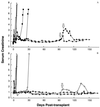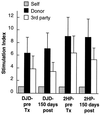CTLA4-Ig and anti-CD40 ligand prevent renal allograft rejection in primates
- PMID: 9238056
- PMCID: PMC23132
- DOI: 10.1073/pnas.94.16.8789
CTLA4-Ig and anti-CD40 ligand prevent renal allograft rejection in primates
Abstract
Selective inhibition of T cell costimulation using the B7-specific fusion protein CTLA4-Ig has been shown to induce long-term allograft survival in rodents. Antibodies preventing the interaction between CD40 and its T cell-based ligand CD154 (CD40L) have been shown in rodents to act synergistically with CTLA4-Ig. It has thus been hypothesized that these agents might be capable of inducing long-term acceptance of allografted tissues in primates. To test this hypothesis in a relevant preclinical model, CTLA4-Ig and the CD40L-specific monoclonal antibody 5C8 were tested in rhesus monkeys. Both agents effectively inhibited rhesus mixed lymphocyte reactions, but the combination was 100 times more effective than either drug alone. Renal allografts were transplanted into nephectomized rhesus monkeys shown to be disparate at major histocompatibility complex class I and class II loci. Control animals rejected in 5-8 days. Brief induction doses of CTLA4-Ig or 5C8 alone significantly prolonged rejection-free survival (20-98 days). Two of four animals treated with both agents experienced extended (>150 days) rejection-free allograft survival. Two animals treated with 5C8 alone and one animal treated with both 5C8 and CTLA4-Ig experienced late, biopsy-proven rejection, but a repeat course of their induction regimen successfully restored normal graft function. Neither drug affected peripheral T cell or B cell counts. There were no clinically evident side effects or rejections during treatment. We conclude that CTLA4-Ig and 5C8 can both prevent and reverse acute allograft rejection, significantly prolonging the survival of major histocompatibility complex-mismatched renal allografts in primates without the need for chronic immunosuppression.
Figures




References
-
- June C H, Bluestone J A, Nadler L M, Thompson C B. Immunol Today. 1994;15:321–325. - PubMed
-
- Pechhold K, Patterson N B, Craighead N, Lee K P, June C H, Harlan D M. J Immunol. 1997;158:4921–4929. - PubMed
-
- Yang Y, Wilson J M. Science. 1996;273:1862–1864. - PubMed
-
- Grewal I S, Foellmer H G, Grewal K D, Xu J, Hardardottir F, Baron J L, Janeway C A, Flavell R A. Science. 1996;273:1864–1867. - PubMed
Publication types
MeSH terms
Substances
LinkOut - more resources
Full Text Sources
Other Literature Sources
Medical
Research Materials

